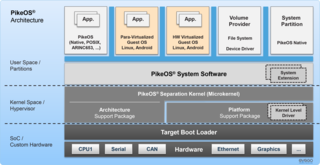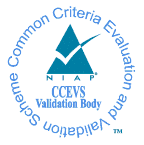Related Research Articles

In computer science, a microkernel is the near-minimum amount of software that can provide the mechanisms needed to implement an operating system (OS). These mechanisms include low-level address space management, thread management, and inter-process communication (IPC).
The trusted computing base (TCB) of a computer system is the set of all hardware, firmware, and/or software components that are critical to its security, in the sense that bugs or vulnerabilities occurring inside the TCB might jeopardize the security properties of the entire system. By contrast, parts of a computer system that lie outside the TCB must not be able to misbehave in a way that would leak any more privileges than are granted to them in accordance to the system's security policy.
L4 is a family of second-generation microkernels, used to implement a variety of types of operating systems (OS), though mostly for Unix-like, Portable Operating System Interface (POSIX) compliant types.
Extremely Reliable Operating System (EROS) is an operating system developed starting in 1991 at the University of Pennsylvania, and then Johns Hopkins University, and The EROS Group, LLC. Features include automatic data and process persistence, some preliminary real-time support, and capability-based security. EROS is purely a research operating system, and was never deployed in real world use. As of 2005, development stopped in favor of a successor system, CapROS.
Multilevel security or multiple levels of security (MLS) is the application of a computer system to process information with incompatible classifications, permit access by users with different security clearances and needs-to-know, and prevent users from obtaining access to information for which they lack authorization.
A hypervisor, also known as a virtual machine monitor (VMM) or virtualizer, is a type of computer software, firmware or hardware that creates and runs virtual machines. A computer on which a hypervisor runs one or more virtual machines is called a host machine, and each virtual machine is called a guest machine. The hypervisor presents the guest operating systems with a virtual operating platform and manages the execution of the guest operating systems. Unlike an emulator, the guest executes most instructions on the native hardware. Multiple instances of a variety of operating systems may share the virtualized hardware resources: for example, Linux, Windows, and macOS instances can all run on a single physical x86 machine. This contrasts with operating-system–level virtualization, where all instances must share a single kernel, though the guest operating systems can differ in user space, such as different Linux distributions with the same kernel.
The National Information Assurance Partnership (NIAP) is a United States government initiative to meet the security testing needs of both information technology consumers and producers that is operated by the National Security Agency (NSA), and was originally a joint effort between NSA and the National Institute of Standards and Technology (NIST).
Multiple single-level or multi-security level (MSL) is a means to separate different levels of data by using separate computers or virtual machines for each level. It aims to give some of the benefits of multilevel security without needing special changes to the OS or applications, but at the cost of needing extra hardware.

PikeOS is a commercial hard real-time operating system (RTOS) which features a separation kernel-based hypervisor. This hypervisor supports multiple logical partition types for various operating systems (OS) and applications, each referred to as a GuestOS. PikeOS is engineered to support the creation of certifiable smart devices for the Internet of Things (IoT), ensuring compliance with industry standards for quality, safety, and security across various sectors. In instances where memory management units (MMU) are not present but memory protection units (MPU) are available on controller-based systems, PikeOS for MPU is designed for critical real-time applications and provides up-to-standard safety and security.
The XTS-400 is a multilevel secure computer operating system. It is multiuser and multitasking that uses multilevel scheduling in processing data and information. It works in networked environments and supports Gigabit Ethernet and both IPv4 and IPv6.

Common Criteria Evaluation and Validation Scheme (CCEVS) is a United States Government program administered by the National Information Assurance Partnership (NIAP) to evaluate security functionality of an information technology with conformance to the Common Criteria international standard. The new standard uses Protection Profiles and the Common Criteria Standards to certify the product. This change happened in 2009. Their stated goal in making the change was to ensure achievable, repeatable and testable evaluations.

Gernot Heiser is a Scientia Professor and the John Lions Chair for operating systems at UNSW Sydney, where he leads the Trustworthy Systems group (TS).
Multiple Independent Levels of Security/Safety (MILS) is a high-assurance security architecture based on the concepts of separation and controlled information flow. It is implemented by separation mechanisms that support both untrusted and trustworthy components; ensuring that the total security solution is non-bypassable, evaluatable, always invoked, and tamperproof.
LynxSecure is a least privilege real-time separation kernel hypervisor from Lynx Software Technologies designed for safety and security critical applications found in military, avionic, industrial, and automotive markets.

A kernel is a computer program at the core of a computer's operating system that always has complete control over everything in the system. The kernel is also responsible for preventing and mitigating conflicts between different processes. It is the portion of the operating system code that is always resident in memory and facilitates interactions between hardware and software components. A full kernel controls all hardware resources via device drivers, arbitrates conflicts between processes concerning such resources, and optimizes the utilization of common resources e.g. CPU & cache usage, file systems, and network sockets. On most systems, the kernel is one of the first programs loaded on startup. It handles the rest of startup as well as memory, peripherals, and input/output (I/O) requests from software, translating them into data-processing instructions for the central processing unit.
An embedded hypervisor is a hypervisor that supports the requirements of embedded systems.
Fishbowl is a mobile phone architecture developed by the U.S. National Security Agency (NSA) to provide a secure Voice over IP (VoIP) capability using commercial grade products that can be approved to communicate classified information. It is the first phase of NSA's Enterprise Mobility Architecture. According to a presentation at the 2012 RSA Conference by Margaret Salter, a Technical Director in the Information Assurance Directorate, "The plan was to buy commercial components, layer them together and get a secure solution. It uses solely commercial infrastructure to protect classified data." Government employees were reportedly testing 100 of the phones as of the announcement.
In information security, a guard is a device or system for allowing computers on otherwise separate networks to communicate, subject to configured constraints. In many respects a guard is like a firewall and guards may have similar functionality to a gateway.
A system virtual machine is a virtual machine (VM) that provides a complete system platform and supports the execution of a complete operating system (OS). These usually emulate an existing architecture, and are built with the purpose of either providing a platform to run programs where the real hardware is not available for use, or of having multiple instances of virtual machines leading to more efficient use of computing resources, both in terms of energy consumption and cost effectiveness, or both. A VM was originally defined by Popek and Goldberg as "an efficient, isolated duplicate of a real machine".

Genode is a free and open-source software operating system (OS) framework consisting of a microkernel abstraction layer and a set of user space components. The framework is notable as one of the few open-source operating systems not derived from a proprietary OS, such as Unix. The characteristic design philosophy is that a small trusted computing base is of primary concern in a security-oriented OS.
References
- ↑ John Rushby, "The Design and Verification of Secure Systems," Eighth ACM Symposium on Operating System Principles, pp. 12-21, Asilomar, CA, December 1981. (ACM Operating Systems Review, Vol. 15, No. 5).
- 1 2 3 Information Assurance Directorate, National Security Agency, Fort George G. Meade, MD. "U.S. Government Protection Profile for Separation Kernels in Environments Requiring High Robustness," Version 1.03, June 2007.
- ↑ "Common Criteria for Information Technology Security Evaluation," Version 3.1, CCMB-2006-09-001, 002, 003, September 2006.
- ↑ "NIAP" (PDF). www.niap-ccevs.org. Retrieved 2025-01-04.
- ↑ "NIAP". www.niap-ccevs.org. Retrieved 2025-01-04.
- ↑ "The L4.verified Proofs". GitHub . 18 November 2021.
- ↑ "seL4: from General Purpose to a Proof of Information Flow Enforcement". Archived from the original on 2015-12-22. Retrieved 2015-12-20.
- ↑ "Muen - An x86/64 Separation Kernel for High Assurance" (PDF). Archived from the original (PDF) on 2018-06-26.